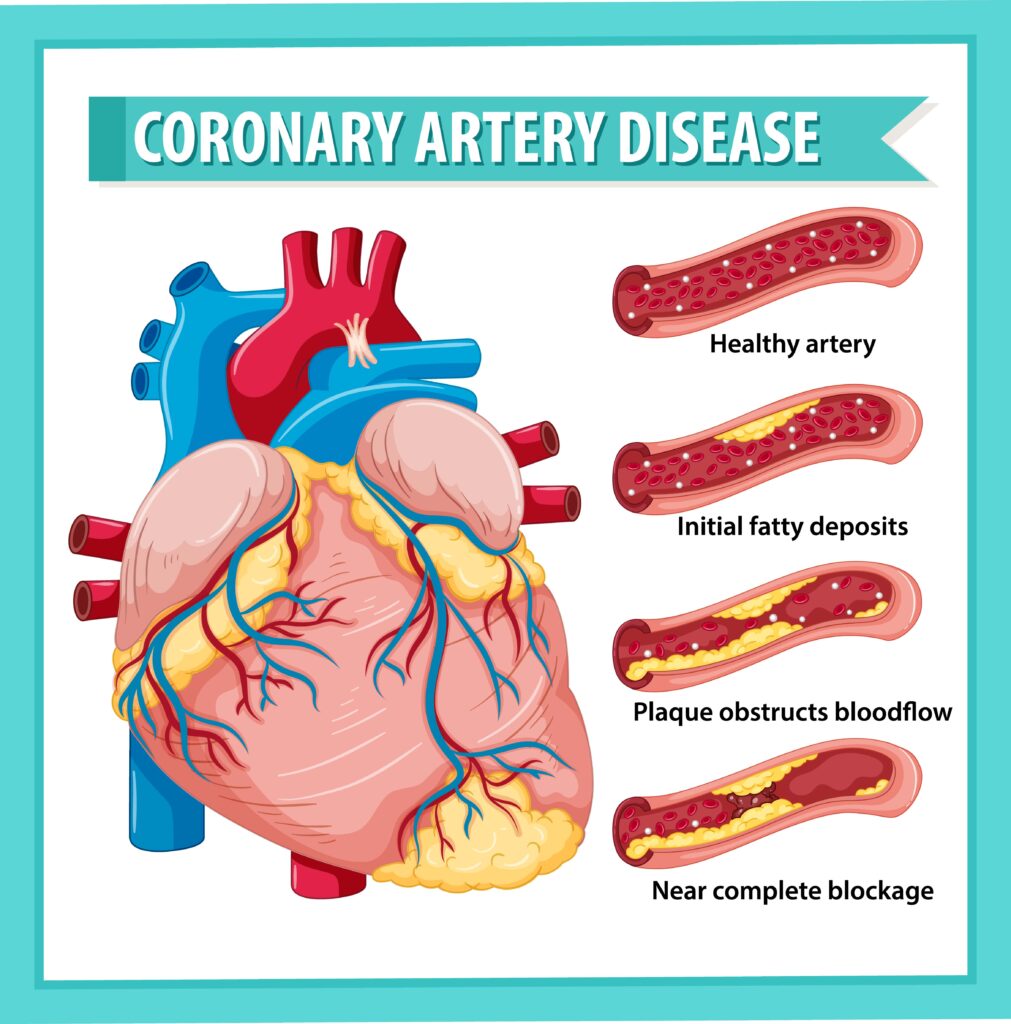Coronary artery disease is the build-up of plaque in the arteries that supply oxygen-rich blood to your heart. Plaque causes a narrowing or blockage that could result in a heart attack. Symptoms include chest pain or discomfort and shortness of breath. Treatments include lifestyle changes and medications that target your risk factors and/or possibly surgery.
Coronary arteries are the blood vessels that supply oxygen-rich blood to your heart muscle to keep it pumping. The coronary arteries are directly on top of your heart muscle. You have four main coronary arteries:
- The right coronary artery.
- The left coronary artery.
- The left anterior descending artery.
- The left circumflex artery.
Coronary artery disease is caused by atherosclerosis. Atherosclerosis is the build-up of plaque inside your arteries. Plaque consists of cholesterol, fatty substances, waste products, calcium and the clot-making substance fibrin. As plaque continues to collect on your artery walls, your arteries narrow and stiffen. Plaque can clog or damage your arteries, which limits or stops blood flow to your heart muscle. If your heart does not get enough blood, it can’t get the oxygen and nutrients it needs to work properly. This condition is called ischemia. Not getting enough blood supply to your heart muscle can lead to chest discomfort or chest pain (called angina). It also puts you at risk for a heart attack.
Coronary artery disease happens in everyone. The speed at which it develops differs from person to person. The process usually starts when you are very young. Before your teen years, the blood vessel walls start to show streaks of fat. As plaque deposits in your artery’s inner walls, your body fights back against this ongoing process by sending white blood cells to attack the cholesterol, but the attack causes more inflammation. This triggers yet other cells in the artery wall to form a soft cap over the plaque.
This thin cap over the plaque can break open (due to blood pressure or other causes). Blood cell fragments called platelets stick to the site of “the injury,” causing a clot to form. The clot further narrows arteries. Sometimes a blood clot breaks apart on its own. Other times the clot blocks blood flow through the artery, depriving the heart of oxygen and causing a heart attack.

Symptoms of Coronary Artery Disease
You may not know you have coronary artery disease since you may not have symptoms at first. The buildup of plaque in your arteries takes years to decades. But as your arteries narrow, you may notice mild symptoms that indicate your heart is pumping harder to deliver oxygen-rich blood to your body. The most common symptoms are chest pain or shortness of breath, especially after light physical activity like walking upstairs, but even at rest.
Sometimes you won’t know you have coronary artery disease until you have a heart attack. Symptoms of a heart attack include:
- Chest discomfort (angina) described as heaviness, tightness, pressure, aching, burning, numbness, fullness, squeezing or a dull ache. The discomfort can also spread to or only be felt in your left shoulder, arms, neck, back or jaw.
- Feeling tired.
- Dizziness, lightheadedness.
- Nausea.
- Weakness.
- Symptoms of a heart attack in women can be slightly different and include:
- Discomfort or pain in the shoulders, neck, abdomen (belly) and/or back.
- Feeling of indigestion or heartburn.
- Unexplained anxiety.
- Cold sweat.
Procedures and surgery
Interventional procedures are nonsurgical treatments to get rid of plaque buildup in the arteries and prevent blockages. Common procedures are balloon angioplasty and stenting. These procedures are done with a long, thin tube called a catheter. It is inserted into an artery in the wrist or the top of the leg through a small incision and guided to the blocked or narrowed area of the artery. The balloon widens the diameter of the artery to restore blood flow to the heart. A stent (a small metal spring-like scaffold) is left in place to keep your artery open.
Coronary artery bypass graft (CABG) surgery involves creating a new path for blood to flow when there is a blockage in the coronary arteries. In most cases, the surgeon removes blood vessels from your chest, arm or leg, and creates a new pathway to deliver oxygen-rich blood to the heart.
If traditional treatment options are not successful, your cardiologist may recommend other treatment options, such as enhanced external counterpulsation (EECP). In this procedure, inflatable cuffs (like blood pressure cuffs) are used to squeeze the blood vessels in your lower body. This helps improve blood flow to the heart and helps create natural bypasses (collateral circulation) around blocked coronary arteries. Enhanced external counterpulsation is a possible treatment for those with chronic stable angina who can’t have an invasive procedure or bypass surgery and don’t get relief from medication.
If you require any further information, feel free to contact us at [email protected].

